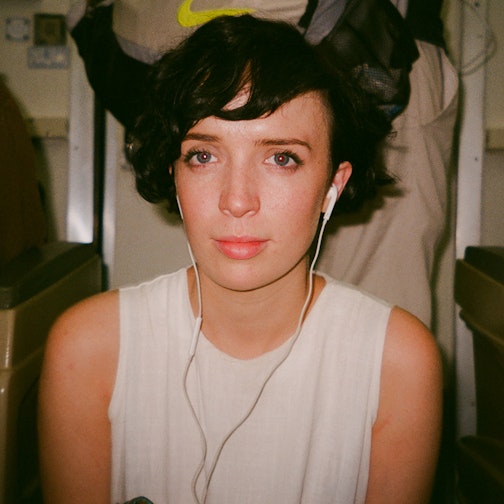Foundations and corollary actions: 4A’s Twenty Years symposium
Isabelle Hore-Thorburn
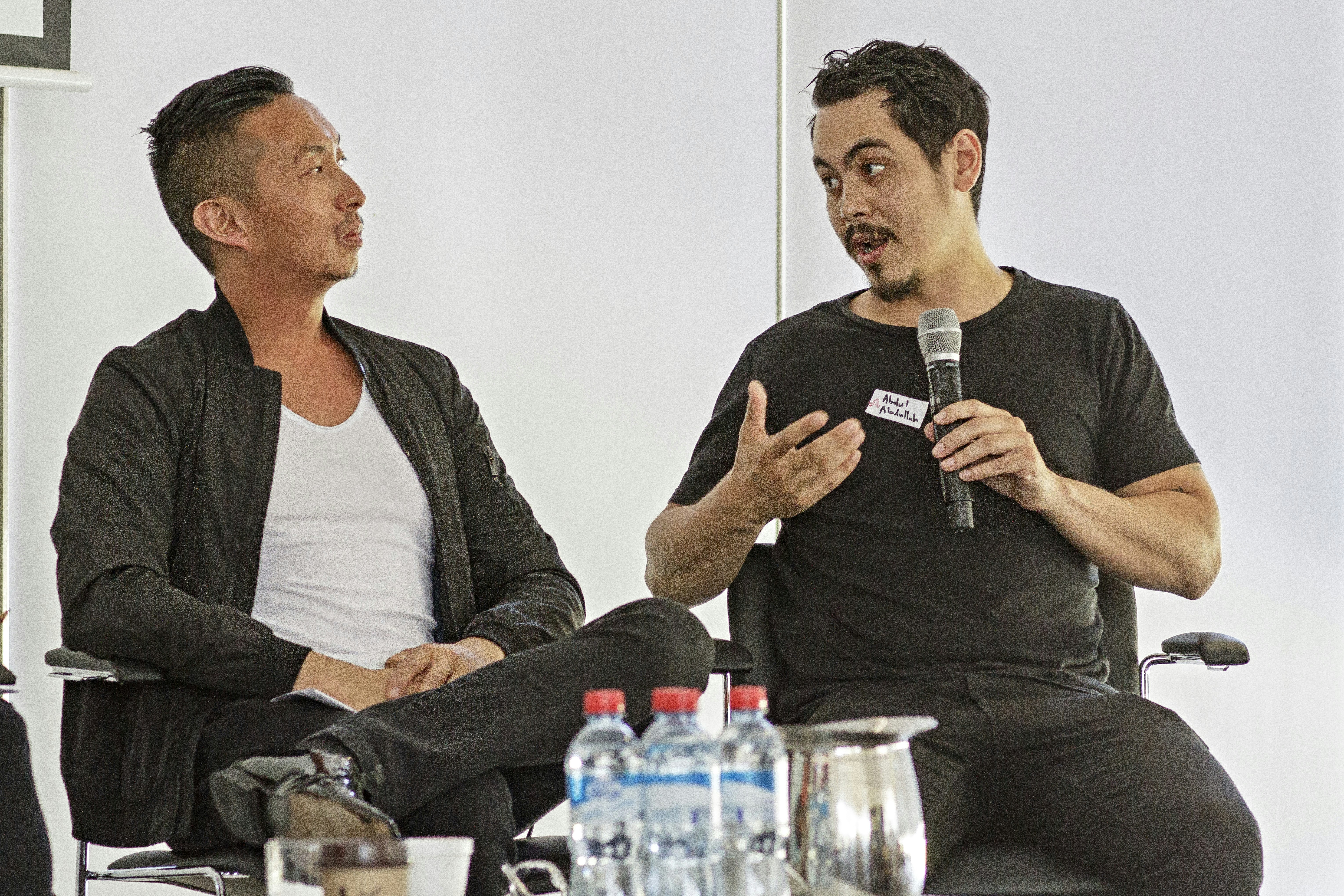
Owen Leong and Abdul Abdullah, Twenty Years – 4A Symposium, University of Sydney, 4 November 2016. Image courtesy The Power Institute and 4A Centre for Contemporary Asian Art; photo: Matthew Venables.
Session one: the last twenty
Most imagine that the arc of history curves towards progress and, in turn, we look to our own histories to affirm the trajectory of that progress and the possibility that we are implicated in it. In the months leading up to 4A Centre for Contemporary Asian Art’s twenty-year anniversary celebrations, the organisation looked to the accumulation of assorted material in its own archive in an effort to map a sense of its own identity through its past. The principal result of this was Twenty Years, a day-long symposium held at the University of Sydney in the first week of November 2016. And so it followed that the first of the symposium’s panel conversations spoke to that same undertaking, looking at its twenty-year history to better understand its role and future. In her opening remarks 4A’s director Mikala Tai proposed that by engaging with some of 4A’s original members we might better understand ‘what we stood for, who we are and where we think we need to go.’ These appear to be three discrete concepts, yet much of the subsequent panel discussions (as well as decades of archival material posted on 4A’s rebranded website launched on the same day) revealed that the same anxiety animates each of these questions: the persistent xenophobia and suspicion of Asia and, more specifically, China within Australian culture. For each of the panellists, it was the particular racial tension of the mid- to late-1990s that drew them to 4A and came to define what it stood for each of them.
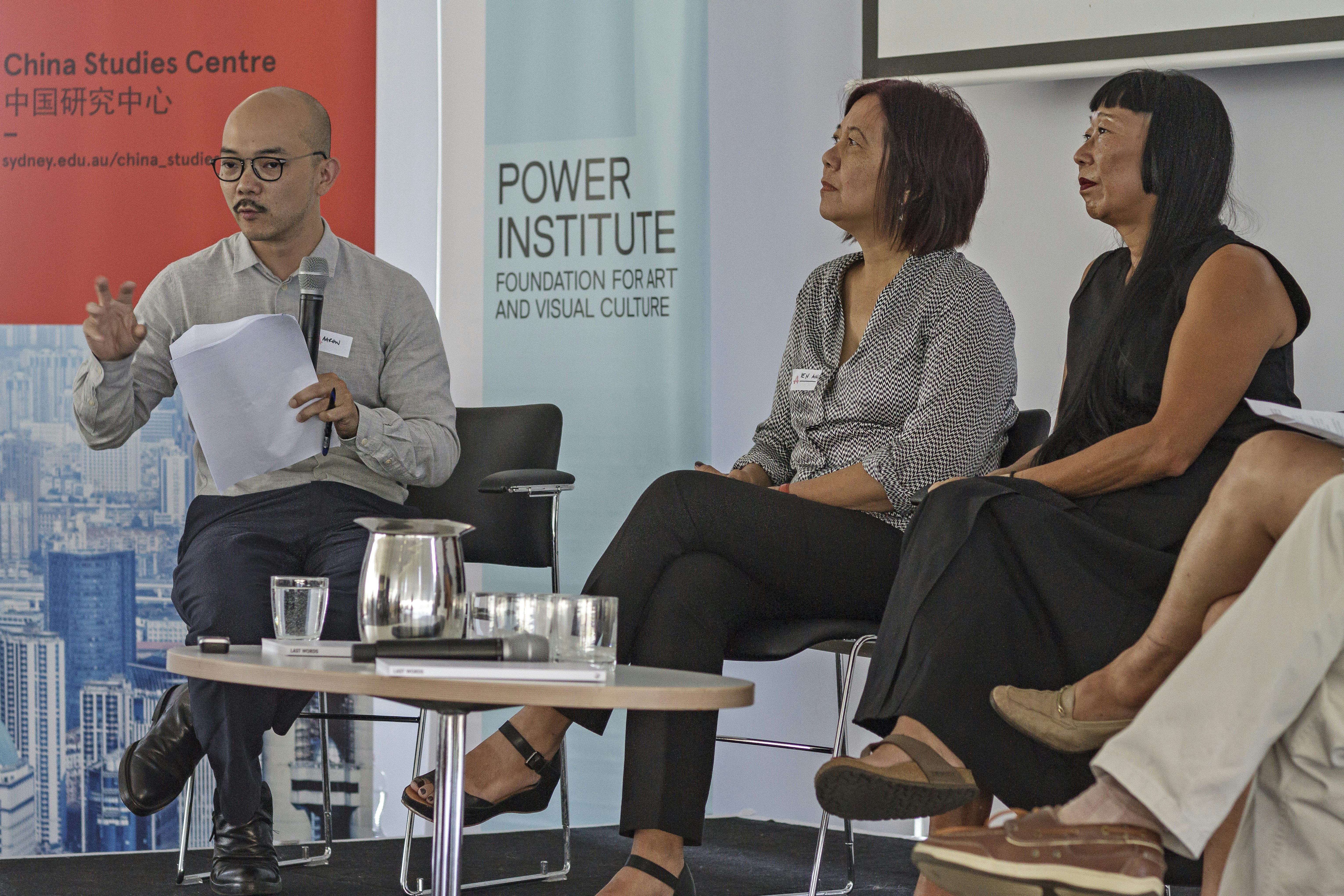
Aaron Seeto, Professor Ien Ang and Dr Lindy Lee. Twenty Years – 4A Symposium, University of Sydney, 4 November 2016. Courtesy The Power Institute, University of Sydney, and 4A Centre for Contemporary Asian Art; photo: Matthew Venables.
Assessing one’s legacy
Moderator of the first session and preceding 4A director, Aaron Seeto, was careful to identify the limitations and scope of such a panel in that ‘it doesn’t deal with much of that pre-history and it doesn’t deal with what was going on in the mid-2000s and onwards.’ The first session’s conversation reflected only one aspect of the organisation’s origin narrative, yet the common experience of the panellists spoke of an insidious and prevailing tension around race relations in the national Australian social climate at the time of 4A’s establishment in 1996. The rhetoric of this period had very real implications for the people who were drawn to the organisation and what they hoped it would achieve. Artist, educator and founding member Victoria Lobregat spoke of ‘feelings of otherness related to childhood experiences’ that defined her sense of identity growing up as an Asian-Australian; scholar Ien Ang further articulated the kind of ‘curse’ of an individual’s ‘asianess’ during that period; while artist Lindy Lee spoke of having her father’s building defaced with racial slurs in the wake of his death. These stories reflect the kind of hostility Asian-Australians were facing in their communities while the rhetoric of Pauline Hanson was rising to prominence in politics and the media during this time and, as is plain, once again in present days. Although dispiriting, personal retelling of these experiences help to illuminate the motivations for some Asian-Australians to so keenly embraced 4A and its mission from the outset.
What was 4A?
For the panellists, 4A’s establishment represented a new kind of space in the city, a base from which to stage a resistance to the reductive and dangerous language—and the corollary actions words often prompt—that defined the period. 4A represented a locus for a more complex and challenging conversation about identity at a time when, as founding artist and committee member Daachi Dang identified, society offered ‘a mixed message about what Asian culture is’. ‘We were questioning who we are and what kind of country we want to be,’ Dang recalled.
Racial tensions were not the only reason why artists sought a public platform to explore ideas of Asian identity and why the sense of community that 4A provided seemed to occupy such a necessary space. This early period approaching the close of the millennium was marked by a newfound interest within Australian art circles in the art of Asia, coupled with a continued ambivalence towards the art and experiences of Asian Australians. Significantly, the 1993 tour to Sydney’s Museum of Contemporary Art of the seminal exhibition Mao Goes Pop, was one the first instances of a mainstream exhibition of contemporary Chinese art (specifically the Chinese avant-garde art of the post-Tiananmen era) was seen by the international audiences in a mainstream institution outside of China. In the same year, the Asia Pacific Triennial of Contemporary Art in Queensland began, though neglected to include Australian artists of Asian descent. In response, founding member of 4A and symposium panellist John Young (with Christina Davidson, Donald Fitzpatrick and Vicente Butron) helped to organise a national conference for ‘Australian Visual Arts in An Asian Context’ at the Sydney College of the Arts that looked not at the popularity of Asian art in Australia but at Asian Australians artists within Australia. It was this conversation, as well as Ien Ang’s seminal 1996 essay ‘The Asian Turn’ that acted as touchstones for a kind movement that fed into the establishment of 4A and the language of both conference and paper can be traced through subsequent articles and essays about 4A and contemporary Asian art in Australia.
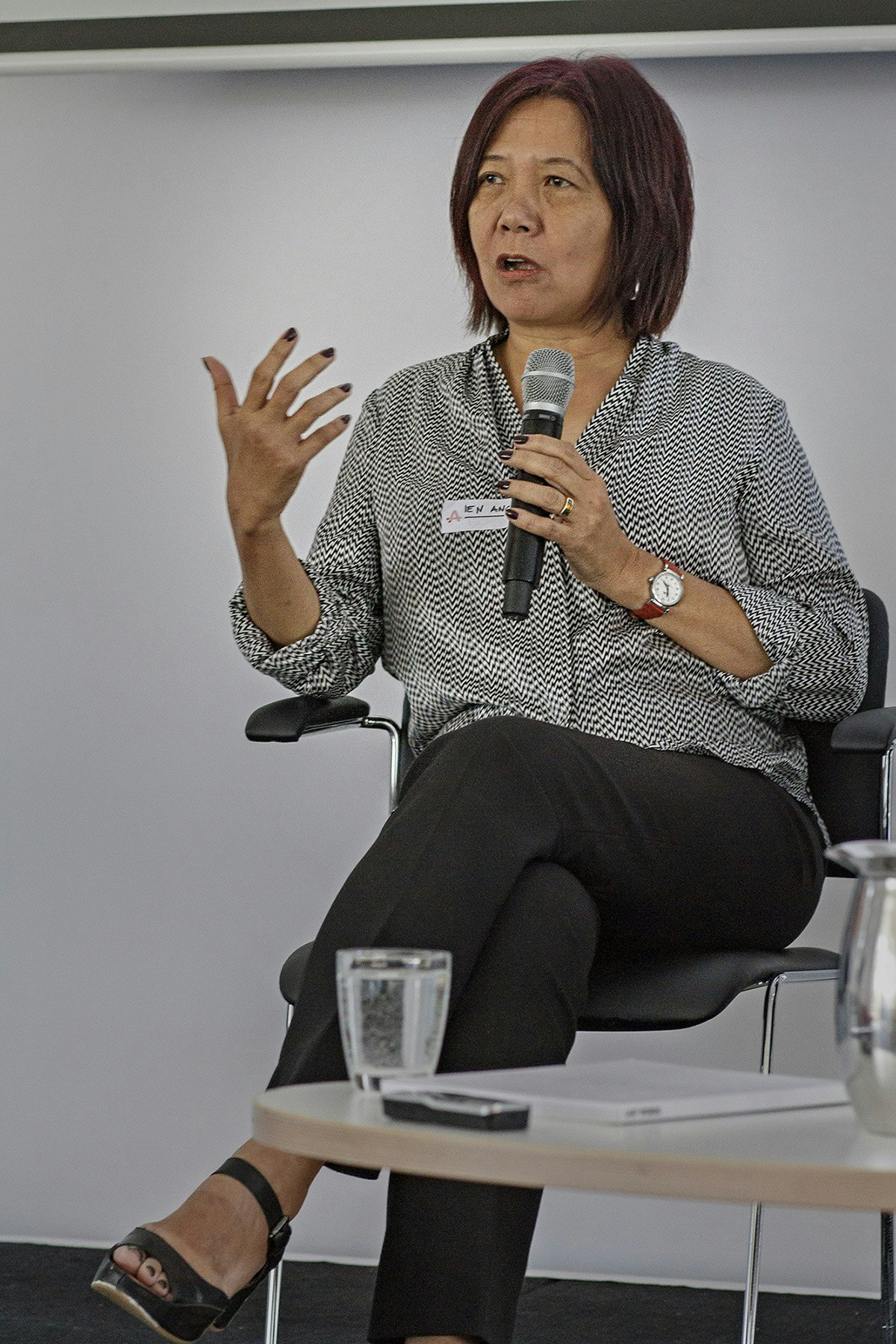
Professor Ien Ang, Twenty Years – 4A Symposium, University of Sydney, 4 November 2016. Image courtesy The Power Institute, University of Sydney, and 4A Centre for Contemporary Asian Art; photo: Matthew Venables.
Evaluating success
Given the circumstances that contributed to the formation of 4A and the objectives that it encouraged, we might look for a more nuanced and less dogmatic cultural language for talking about Australia’s relationship to and with Asia, and the place of Asian Australians within our national imagination now that twenty years have elapsed. This would, perhaps, provide a sense of progress and reflect 4A’s success as an institution. It is therefore disheartening that as, chair of the 4A board Edmund Capon noted in his opening remarks, ‘the language and attitude not only of two decades ago, but three or four decades ago’ are reoccurring in our media, politics and conversations. One might argue that they never abated. What does it mean, then, for an organisation that endeavours to facilitate cultural dialogue between Australia and Asia that many of the attitudes that it hoped to challenge remain or have in some quarters perhaps even worsen? We would hope that cultural attitudes to Asian Australians would have improved in the past two decades and, as the panellists identified, for communities living in inner cities they have. However, as an educator working in regional areas of NSW, Victoria Lobregat identified that ‘things have not improved’, and that similar sentiments exist within regional classrooms for a new generation of Australians to that of their parents and grandparents. Troubling also are the macro observations of Ien Ang who warned that the re-emergence of leaders espousing hatred such as Pauline Hanson should be understood within a context of ‘a far darker situation’ indicated by the enormous backlash against cosmopolitanism, diversity, and the ascendency of Trump, the Brexit movement and others. Ang suggested that the present situation is in many ways more dangerous than it was in the nineties and more problematic.
Like the panellists, many of the audience members spoke about the repetition of many of the conditions and attitudes that lead to the formation of 4A. One audience member asked why ‘the Australian political class rediscover Asia every twenty years … why don’t you go on from where you are?’ Another audience member posed the question of what he saw as the ‘clear pattern of thought transferring itself to outsiders which we are all well aware of in this room because of our relationship to Australian prejudice’, and the way we relate to Asia and Asian Australians: ‘why is it still there… why is it not smashed, or conquered, or circumvented?’ Does the recurrent question of Asia and the continued racism experienced by Asian Australians indicate a failure of 4A? Alternatively, is it neither the role of the artist nor the artist-run initiative to deliver progress and should we therefore rethink the way we measure their efficacy? In response to a suggestion from the audience that artists and 4A specifically should promote greater understanding of Asia and Asian culture in order to diminish the cultural tendency towards racial prejudice, Aaron Seeto suggested that it was well within their (the artists’) mandate to remain apolitical if they chose. Perhaps that same sovereignty should be extended when thinking about the efficacy of an organisation like 4A. While the organisation’s origin was— and is—deeply impacted by the politics of the time, we should not measure success on their capacity to change the political landscape. Nor should we see the reappearance of concerns about our relationship with Asia as a failure to enrich the cultural conversation about our engagement with the region.
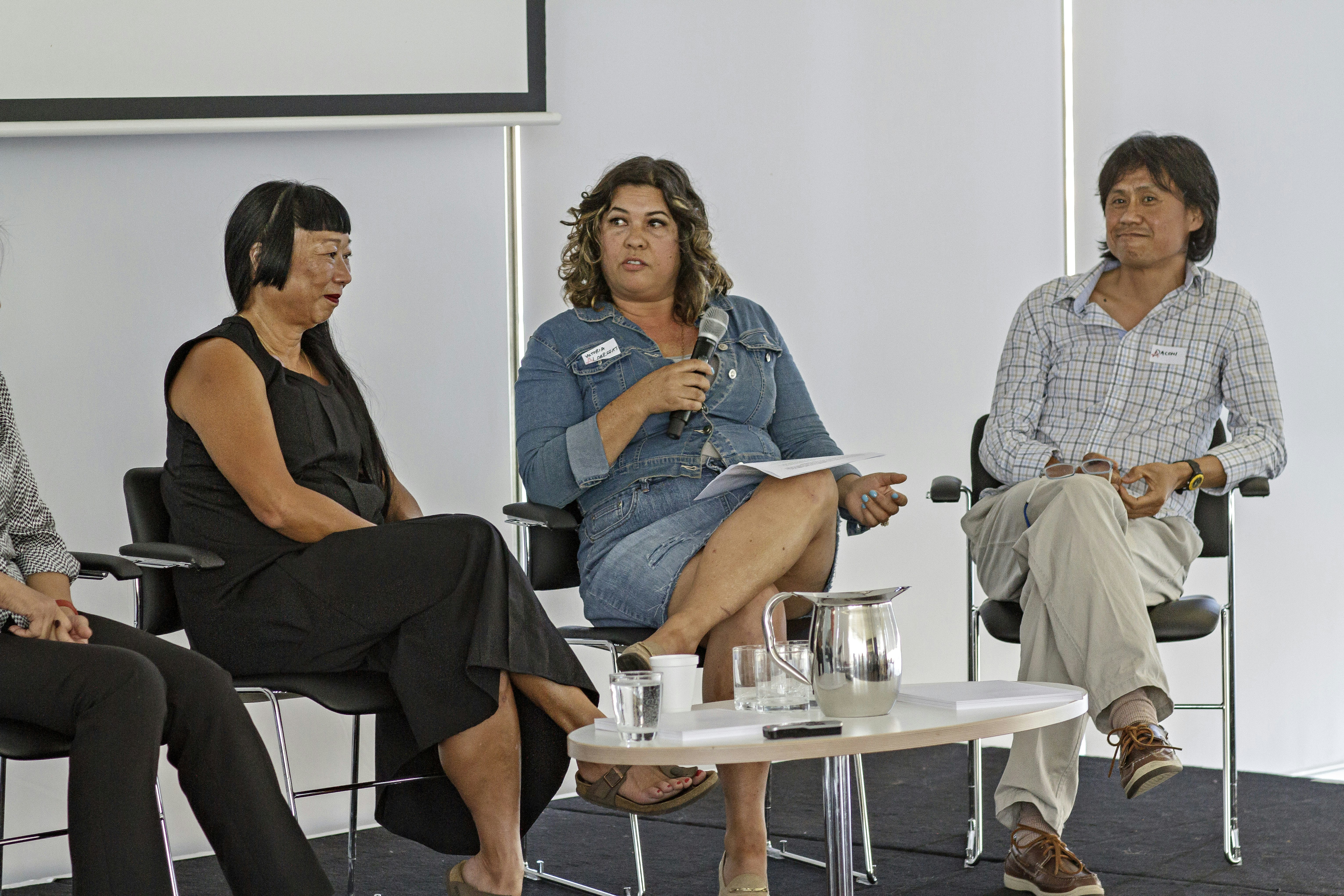
Dr Lindy Lee, Victoria Lobregat and Dr Dacchi Dang. Twenty Years – 4A Symposium, University of Sydney, 4 November 2016. Image courtesy The Power Institute, University of Sydney, and 4A Centre for Contemporary Asian Art; photo: Matthew Venables.
Rediscovering Asia
Lindy Lee eloquently proposed that ‘it’s this condition, the human condition to live historically and unhistorically simultaneously.’ Our apparent failure to reconcile our nation and ourselves with Asia (while clearly inflected by racism) also reflects a more existential question of who we are as individuals and as a community. Lee suggests that each generation has to learn its relationship with the world in its own way. This coming back to the question of Asia and our relationship with it may not necessarily indicate a failure to resolve a founding objective. Instead, it reflects a fidelity to its artists and community. One could argue that at this particular point—and because of a resurgence in xenophobic rhetoric towards new migrants—4As existence is most relevant and most needed. 4A stands for a kind of counter position within the arts and Australian culture more broadly. Seeto proposed that as an institution 4A ‘doesn’t fit into broader cultural histories because it exists in spite of them’. One might argue that it is because of this rejection of the essentialising language and thinking that relates to the Asian Australian experience, as well as to contemporary art, that positions 4A as a unique and innovative organisation.
The most heartening evidence of ‘what we stand for’, and where 4A’s value as an institution lies and is most visible, can be found in a deeper and more integrated engagement with Asia. The panel identified that 4A was initially defined in terms of a resistance to the racial and political tensions of the mid-1990s towards the racial ‘other’. One of the most positive aspects that came from the reflections of the original associate members of 4A was their interrogation of the apparent repetition of history and how that figured into 4A’s own history. While we are asking many of the same questions now, we do so with a different attitude about ourselves; Lee observed, ‘I see it in the younger generation, people are taking pride in being Asian now.’ In an increasingly globalised world younger generations of Asian Australian artists are no longer trying to garner validation from a system that appears incapable of confronting its entrenched prejudices. Instead, they are looking to Asia in order to express themselves and enrich their practice. 4A has, through its artistic programs, advocacy and professional and industry development and community engagement supported that project. There is a marked shift in the organisation’s ambitions. Ang noted that, ‘For an organisation like 4A it’s not just a question of us wanting to be accepted nationally; 4A is at the forefront of a truly transnational, integrated engagement, regionally.’ Also taking the long view, Dachhi Dang observed that ‘there is a big difference in focus from the early stage until now… In the early stage there was more of a focus on our country, whereas now the focus is in Asia as a whole.’ Ang concluded that while we are thinking more as a part of Asia, ‘the Asia that we are engaging with is one that is very specific to the Australian experience.’
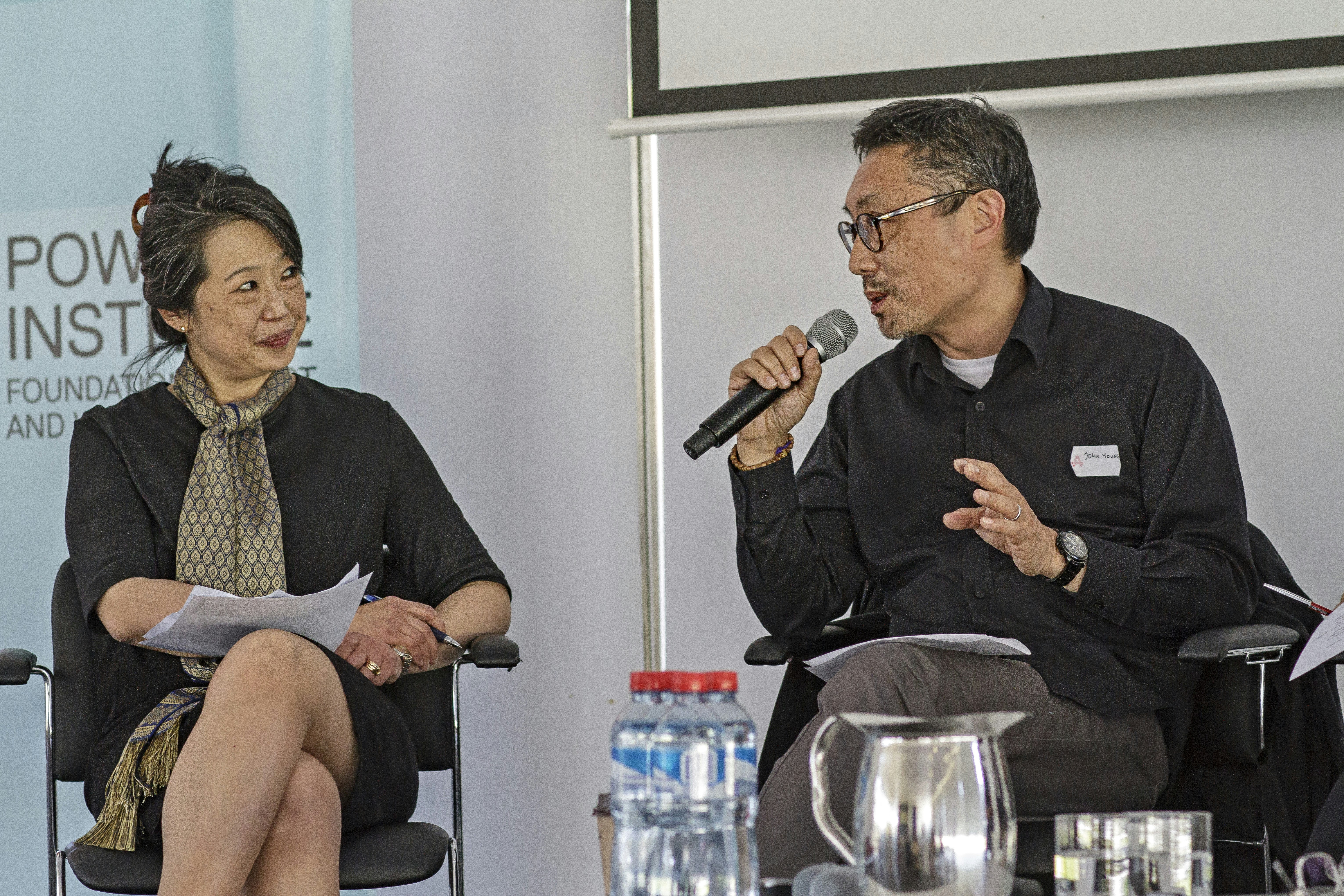
Professor Jacqueline Lo and John Young, Twenty Years – 4A Symposium, University of Sydney, 4 November 2016. Image courtesy The Power Institute, University of Sydney, and 4A Centre for Contemporary Asian Art; photo: Matthew Venables.
Session two: the Asian Australian artist
The second session of the symposium put at its centre the question of ‘the Asian Australian Artist.’ For panellists Abdul Abdullah, Mayu Kanamori, Owen Leong and John Young this designation is seen as having been imposed by an often essentialising Eurocentric gaze. Paradoxically, the term might also operate as a political tool for self-actualisation and for artists to coalesce in resistance to the reductive definitions that it invokes. Over the last twenty years the inherent intricacies of negotiating the hybrid identity of ‘Asian Australian artist’ have been further compacted by changing migration patterns, technologies and media. The diversity of experience comprised on the panel that was expertly chaired by Jacqueline Lo revealed the mutability and complexity of the term and the challenges and opportunities that it presents, for artists as well as the organisations that support them. In the lead up to the symposium, for example, there had been countless conversations between staff in 4A’s office about the inclusion or omission of the hyphen in ‘Asian-Australian Artist.’ The complex relationships that the panellist have with the term and how it relates to their practice and identity reflects the diversity and experience of the panel as well as the politics, liminality and limitations of negotiating a hyphenated identity.
Australian visual art in an Asian context
As an artist, writer, founding member and current Board member of 4A, John Young has made significant contributions to the history and direction of the organisation as well as the discourse around Asian Australian art and identity. Born in Hong Kong, Young moved to Australia in 1967 and studied aesthetics at the University of Sydney. This was followed by painting and sculpture at Sydney College of the Arts where his investigation of Western late modernism prompted significant and important phases of work from a bi-cultural viewpoint. He was thus uniquely positioned to speak on the theme of the Asian Australian artist. As many of the conversations throughout the symposium corroborated, Young’s contribution to the 1993 Sydney College of the Arts symposium Australian Visual Arts in an Asian Context enriched and complicated the existing rhetoric concerning Asian Australian identity in the arts in Australia, and more specifically Sydney, in that period. It was fitting that in her first question, Jacqueline Lo asked Young to discuss what organisations (like 4A) mean in terms of his practice and politics as an Asian Australian artist. In response, he offered three fundamentals of what the term itself might mean. Young proposed that to be an Asian Australian artist is ‘to have the freedom in describing or reimagining the values of my heritage or values from greater Asia’, ‘to confront and make better the dominant world view’, and ‘to hope for an adequate acknowledgment of this change.’
The clarity and optimism of Young’s conceptualisation of ‘Asian Australian artist’ and its invocations can be explained by the cultural and political attitudes towards that demographic during the time that he was socialised into it. Lo observed that ‘at the beginning of multiculturalism, we [Asian Australians] were starting to feel very comfortable.’ Around the time of Australia’s bicentennial marker of the arrival of the First Fleet, for example, issues of ‘asianisation’ had yet to pique the interest of the Australian zeitgeist—‘for people of my generation, we were beginning to feel integrated.’ It was during this period of relative optimism that Young began to interrogate the identity of the Asian Australian artist and it is this tenor of multiculturalism and egalitarianism that underscores his definition. Lo recalled that ‘the period of the mid nighties was a period of heightened racism where suddenly we felt yellowed and browned all over again’, and it was that period that ‘brought together the solidarity platform called Asian Australia’ as a political identity. Young’s assertion that he no longer has an identity seems somewhat at odds with Lo’s description of the coalescing of young Asian Australian artist’s around the term as a political identity. It is not so much a denunciation as a putting aside or de-centring of his Asian Australian identity within his practice. It does not necessarily conflict with the specificity of the definition that he lays out for the Asian Australian artist, but it does point to a specific relationship with an identity that he would seem to inhabit.
Artists of John Young and Lindy Lee’s generation were often forced to, as he describes, ‘put on white face’ until the postmodernism of the 1980s helped liberate them from such charades. He identifies this as a moment where he could really start ‘looking at being an Asian Australian artist.’ It is significant that for artists of this generation the interrogation of their hyphenated identity within their practice was a conscious decision to pursue personally, rather than one that was enacted upon them. The interrogation and concentration on Asian identity was not a popular one for John and he ‘lost half of his friends’ consequently. The optics of ‘putting on white face’ is interesting as it allows for a taking off as well. The pervasiveness of the Eurocentric gaze in contemporary art and culture before and around the time of the bicentennial positioned the artists’ ‘asianess’ at the periphery. It seems less realistic in a post-Hanson and post-9/11 world that artists of the international diaspora are able to relinquish their designation as an ethnic or racial other.
Artists of John Young and Lindy Lee’s generation were often forced to, as he describes, ‘put on white face’ until the postmodernism of the 1980s helped liberate them from such charades.
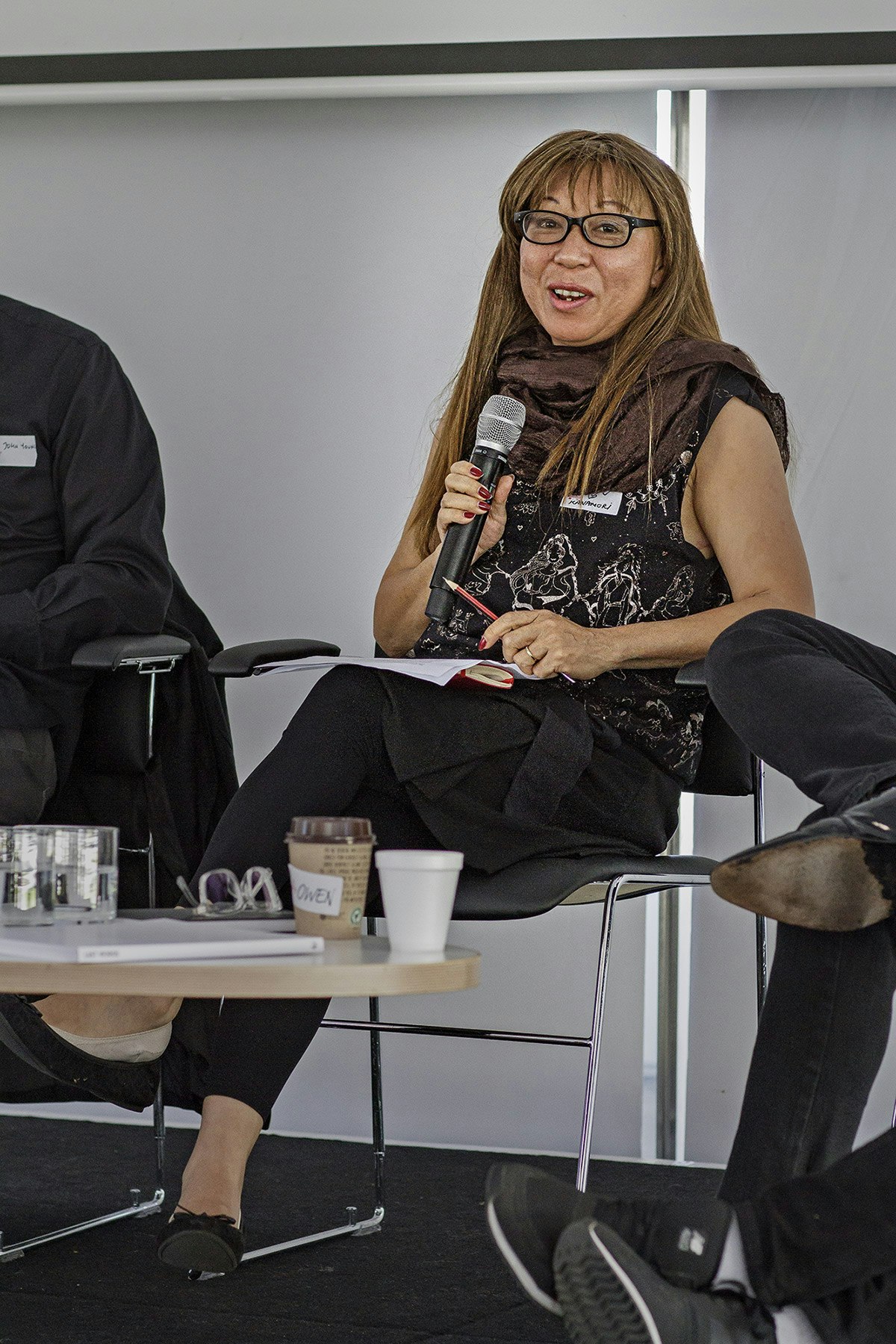
Mayu Kanamori, Twenty Years – 4A Symposium, University of Sydney, 4 November 2016. Image courtesy The Power Institute, University of Sydney, and 4A Centre for Contemporary Asian Art; photo: Matthew Venables.
Politics of recognition
For Abdul Abdullah and Mayu Kanamori, their identity as ‘Asian Australian artist’ was ascribed to them. Kanamori recalls, ‘I didn’t know I was an Asian Australian artist until I met Jackie Lo’, and Abdullah joked that it was not in fact until he was asked to sit on the symposium panel that he had ever thought of himself as an Asian Australian artist. Though both artists saw recognised the humour of their respective situations, their shared experience has significant implications. Kanamori differentiates between the colonial history of many Asian nations and that of Japan whose empire comprised colonies in Korea, China and Taiwan. Abdullah conceptualised the Asian experience explicitly as a colonised experience and looked to his own Indonesian heritage and the history of his family fighting against the colonising Portuguese, Dutch and the British. His body thus evidences the legacy of the colonial struggle. These two disparate colonial histories are in many ways erased or obscured by the ascription of the term Asian Australian artists to them and their heritages. They are discursively stripped of their specific histories. Their experience demonstrates the limitations of the term and its tendency to essentialise the experience and history of these communities and individuals. For artists of a younger generation, it is not so much an ‘opportunity to describe or reimagine the values of their heritage or values from greater Asia’, as Young proffered, but a mode of obliterating the multiplicity of experiences histories and futures that the Asian experience comprises.
Who we make work for
The often homogenising cloak of Australian culture places the Asian experience under erasure. While certain aspects of that experience (however constructed) are visible, complexities and diversities of those cultures and their histories are constantly being effaced. It has thus become important for Asian Australian artists in particular to disarticulate the colonial features of this identity label and push against the assumptions it implies. It is in the last twenty years of 4A’s activities that we can observe the negotiation and renegotiation of ‘Asian Australian artist’ and how artists work within and against the term. The different ways that artists understand and conceptualise their Asian Australian identity so richly articulates the complexity, hybrid, and political potency of the designation. For Abdul Abdullah and Owen Leong, their practice is a space to disrupt the hegemonic power of whiteness and an active intervention of the exclusionary conceptions of Australianness as essentially Anglo-European. For the two artists, their research and practice became the apparatus for locating their bodies. Leong’s practice is deeply inflected by that pursuit; he recalls asking as a child, ‘I was always looking for my body … where is my body in this cultural landscape?’ Similarly, Abdullah stated, ‘I’m making art for the nine-year-old version of me who is looking for themselves.’ As two artists grappling with ideas of islamophobia and queerness (among other things) respectively, both Abdullah and Leong recognise that in many ways it is their politicised bodies that are at the centre of their practice as Asian Australian artists. Lo identified:
This negotiation between the kinds of politics of recognition that drives a lot of your work, particularly both of you, Abdul and Owen, I can hear that very clearly—recognition and insistence on ‘we’re here’ and ‘we’re naming and claiming’. But I’m also hearing from Mayu and John, alongside that lies a responsibility and reciprocity as well, and it’s a really interesting tension and obviously it’s not an exclusive one.
These two predispositions might be initially read along generational lines. Yet it would also seem that the attitude and interaction with ‘Asian Australian artist’, as a signifier, has more to do with the socialisation of their Asian Australianess. For Leong and Young, as they expressed themselves their Asian Australianess has political agency and they use it as a tool. For Abdullah and Kanamori, they did not ‘know’ they were Asian Australian artists until they were told. Interestingly Kanamori found that ‘the more I become aware of my Asian Australianess, the more I want to challenge the preconceived notions that come with that.’ Their relationship is more responsive, whereas Leong and Young’s is a political identity that they were able to articulate before it was inscribed on them.
Claiming one’s difference as an Asian Australian artist and turning it into symbolic capital has historically proven to be an effective strategy for those excluded and erased by the hegemonic whiteness of the Australian arts landscape. Yet as the conversation revealed, the term itself can also reiterate those structural problems. Given the diversity and complexity of experienced comprised in the term ‘Asian Australian artist’ it is perhaps most important that there are places like 4A where those complexities can be explored without essentialising them. Jacqueline Lo concluded by proposing:
… a platform for resistance and resilience against an overwhelming culture of heightened racism…. a network that looks at capacity building. Building an intelligence around critiquing, problematising and challenging notions of what national identity means, what diasporic identity means, what our politics means, and trying very hard not to homogenise.
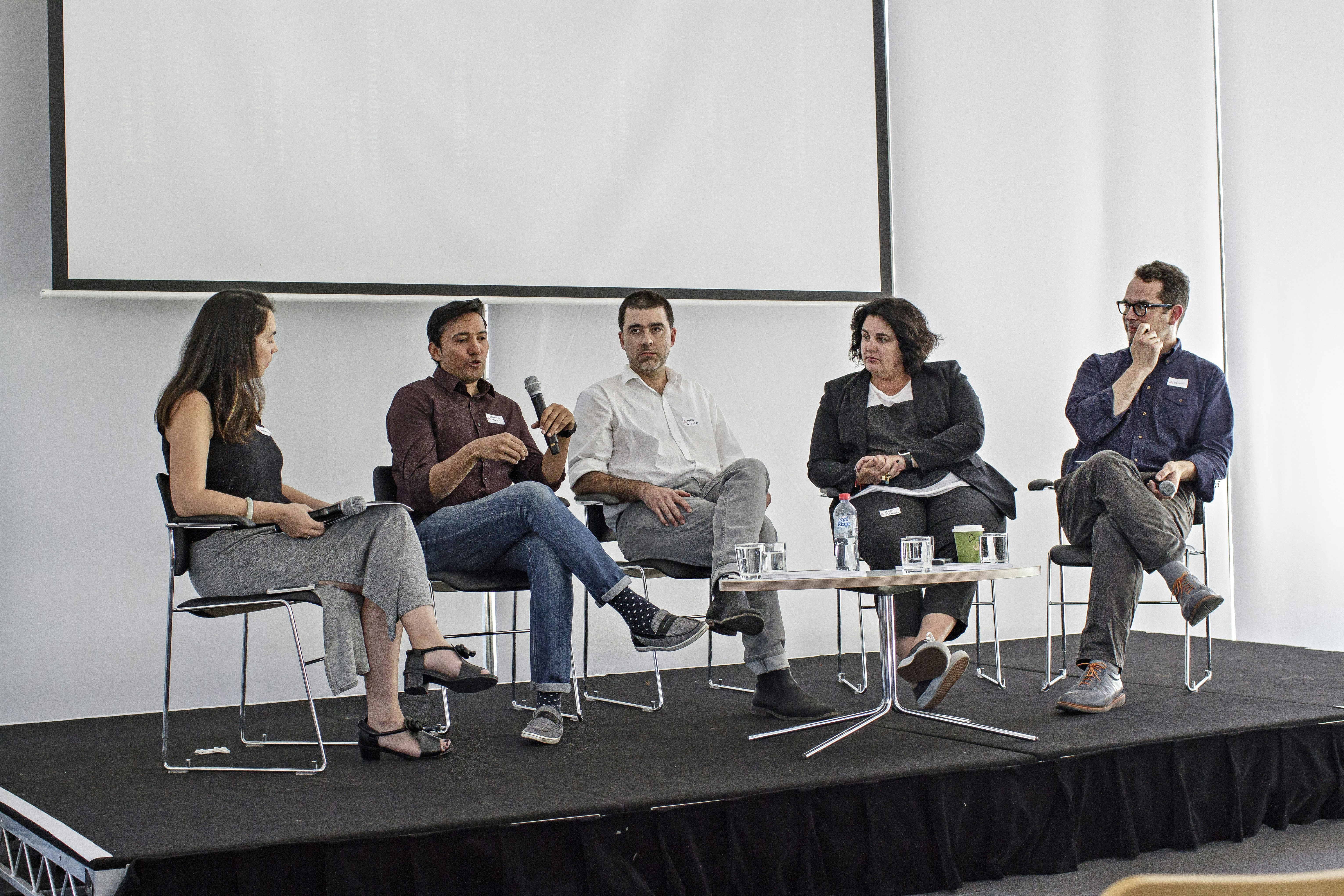
Dr Mikala Tai, Dr Abdullah M. I. Syed, Pedro de Almeida, Alexandra Bowen and Dr Stephen Whiteman, Twenty Years – 4A Symposium, University of Sydney, 4 November 2016. Image courtesy The Power Institute, University of Sydney, and 4A Centre for Contemporary Asian Art; photo: Matthew Venables.
Session three: the next twenty
As the previous sessions attest, 4A has reshaped and refocused its objectives to reflect the shifting politics of Asian Australian artists, a new intellectual troubling of boarders and definitions of region, as well as a changing global migratory footprint. In her opening remarks, Mikala Tai acknowledged 4A’s long history of ‘responding to migrant stories that become Australian stories’, and that as a country of migrants we and specifically our institutions need to respond to those narratives because they inevitably become our own; qualifying ‘If they aren’t our stories now, they’ll be our stories tomorrow.’ Much of the symposium’s discussions had focused on the organisation’s origin story and how 4A had initially responded to Vietnamese, Chinese, and Filipino stories because it was predominantly artists from those diasporic groups that were ‘envisaging a space that could tell their story, and where the public could interact with what they thought of as themselves and what they thought Australia should be.’ The tone of optimism that animated much of the symposium’s interchanges were, however, tempered by prevailing concerns about the new wave of heightened racism in Australia as well as globally. What many of the artists, collaborators and audience members reiterated was the urgent need for 4A to continue its mandate of telling migrant stories and giving space for their complexities. In this particular political and economic moment, the greatest questions for 4A is how, as an organisation, it might remain faithful to its founding objectives will embracing the particular challenges of the epoch.
Looking forward to the next twenty years, Mikala Tai asked 4A collaborators from government, institutions, and the arts community ‘what 4A does’ and ‘what we should be doing and how we should be thinking about what we do?’ How could 4A remain faithful to its mandate of responding to migrant stories as its remit continues to grow in both Australia, the Asia region and an increasingly globalised art world? To interrogate these questions, the symposium’s third and final session presented a panel comprising Alexandra Bowen of the City of Sydney, the local government council with whom 4A has enjoyed a strong and consistent relationship with since its inception; artist Abdullah M. I. Syed, who has been curated into several 4A projects over recent years and whose involvement reflects the organisations’ increasing engagement in South Asia; 4A program manager Pedro de Almeida, who joined the panel to offer further insight into the strategy for the organisation’s future and to articulate the purpose and significance of the 4A Papers, launched only hours earlier; and, finally, Dr Stephen Whiteman of the Art History Department of the University of Sydney was brought into the fold given his expertise in Asian art history and commitment to expanding opportunities for education in the field in and outside of the tertiary sector. Tai began the session by acknowledging the political roots of 4A and the ways in which activism have informed the vision and direction of the organisation. This panel of current and likely future collaborators unpacked how they perceived that relationship will function in the next twenty years, and how they see their roles with the organisation as well as 4A’s relationship with its immediate community and the region.
4A and the university
Stephen Whiteman began by explicating his own academic work which looks at Imperial Chinese court art, and specifically ‘how power imbeds itself and hides itself and encodes itself in art and how propaganda operates.’ Given his intellectual and academic interest in this area, Whiteman confessed he was surprised to learn throughout the course of the symposium of the unambiguously political and activist origins of 4A. Whiteman foregrounded his position within the Art History Department at the University of Sydney to contextualise his own experience and interaction with 4A up until this point, but also to acknowledge the relative absence of art history as a discipline within the day’s conversation and ostensibly in the way that 4A and its members conceptualise the organisation and its history. Though he acknowledged that art history is a conservative field, and that this is particularly true in Australia, 4A presents an exciting and rare opportunity both for students and practitioners of art to rethink the relationship between art and activism. Whiteman stipulated that he did not ‘necessarily experience 4A as an overtly, explicitly political space (4A’s 1997 exhibition Asian Artists Against Racism not withstanding), in his capacity as a university lecturer he expressed that, ‘I don’t experience 4A’s exhibition program as like that, and indeed I would think that for myself as a teacher that type of position in a classroom would be inappropriate in a certain way. I think that I am politicised in the classroom but not in an expressly or overt way.’ He asserted that, ‘the antiracism part of our history, for me, starts with showing up every day and trying to talk as eloquently and as sort of well informed as I can’, and ‘for me that’s what 4A really does—more than being explicitly political, first and foremost you are political by creating a space in which this occurs and staking out that space.’ Whiteman identified a growing relationship with the University of Sydney and its Art History with 4A that could start to find common cause. In many ways, 4A has become an exemplar of how artistic spaces can be places of intellectual and artistic interrogation without having an explicitly political message. An increased engagement with the University presents opportunities for both parties and Whiteman spoke to those opportunities for students of curating and art theory. For 4A, the future relationship with the Art History department of the University of Sydney proposes a further enriched environment for curators and artists, as well as students and audiences to engage with migrant narratives as well as to broader themes and ideas throughout the region.
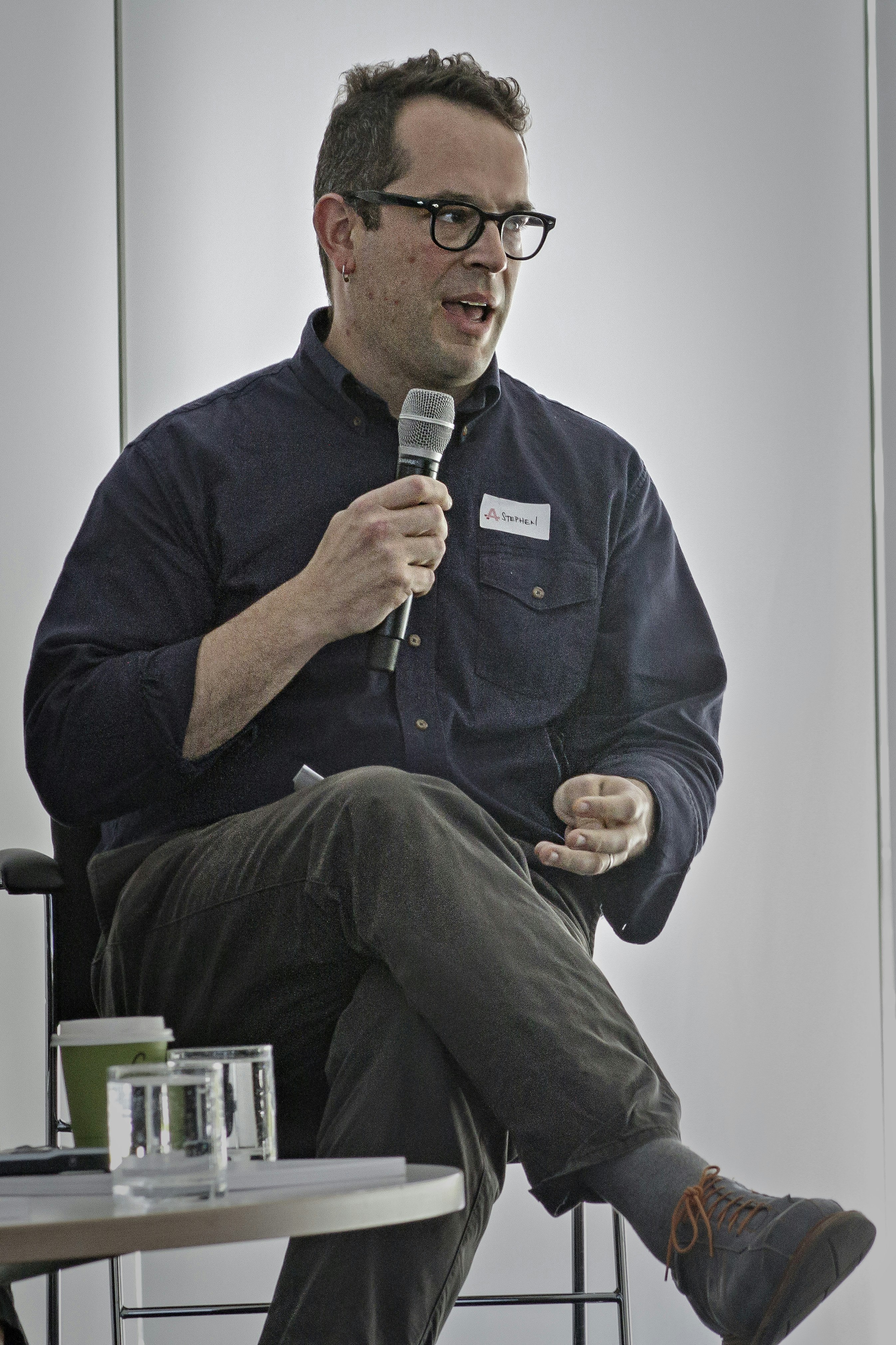
Dr Stephen Whiteman, Twenty Years – 4A Symposium, University of Sydney, 4 November 2016. Image courtesy The Power Institute, University of Sydney, and 4A Centre for Contemporary Asian Art; photo: Matthew Venables.
4A and the City
In her capacity as executive manager of cultural and creative programs at the City of Sydney, and her previous managerial roles with Arts NSW since the early 2000s, Alexandra Bowen has been involved with 4A since the beginning and was heartened to see many people from those early years in the audience. It is interesting, then, that she regarded the question of 4A’s role looking forward to be ‘a challenger’, which is to say ‘to challenge the way people think’ about Asia and about Australia’s place with and within the Asia. While Bowen and Whiteman’s outlooks are not at odds, they do reflect a changing political identity and the way that politics often operates within the organisation and indeed within broader societal structures. Asian Artists Against Racism reflects the very overt politics of 4A, whereas now the curatorial inclusion of artists from South Asia and the Middle East for example most accurately reflects the way 4A is exercising its role. However, rather than exhibiting their works along ethnic or geographic lines, the programming, looking to 2017 and beyond is more thematically grounded in narrative and concept. The non-didactic curatorial language of recent years, and the increased engagement with the University of Sydney among other academic institutions that foreshadow how into the future 4A will challenge the way people think about Asia. It is according to this methodology and logic that the conversation about Asia and the narratives of migrants will be best served, and the often siloed spaces of their discourses will be dissolved.
4A and the artist
For artists like Abdullah M. I. Syed, this decentering on politics of ethnicity is favorable as in his own experience this can delimit ones cultural and commercial viability. For him, ‘politics is part of us now’, and any work, irrespective of the medium or its conceptual underpinnings, it is political because it is art made in this time. To demarcate a work or an artist as explicitly political can, in his experience, devalue it. 4A’s model, however, presents new opportunities for artists like Syed: ‘I believe in poetic activism and I think that’s what 4A is doing … They are not directly commenting on the politics but they are bringing art and aesthetics into it.’ This sentiment echoes that of Whiteman and reflects his perceived role of 4A not to prescribe a political position but to provide a space and opportunities for those conversations to happen. Whether it be as a part of 4A’s annual Beijing Studio Program, Curator’s Intensive, Writer’s Program or public programming, these conversations are not simply looking at ourselves and our community but engaging and integrating those conversations with communities internationally, and particularly in Asia.
4A Papers
For the editor of the newly established 4A Papers, Pedro de Almeida, 4A has a responsibility to make accessible the kinds of ideas, conversations and denser analyses that arise from the its rich program as well as that of other organisations, regionally and internationally. Responsibility describes a duty—4A Papers is the most recent manifestation of the organisation’s commitment to that duty. For its editor, the online Papers is a platform for responsiveness, not only to the most urgent issues and ideas of the moment, but equally important, from a diverse range of voices and experiences. De Almeida explained:
I mention responsibility because I was telling a colleague [about 4A Papers] and they asked, ‘is 4A in the business of that now? You’re going to have critical writing on the website? What if you don’t agree with it? What if someone else doesn’t agree with it?’ I found it bizarre—we’re doing that anyway. We put on programs, we curate exhibitions and a point of view is implicit in that, a curatorial point of view. By editing a collection of papers that you may or may not agree with, it’s not about putting rubber seals on writers’ points of view, although there is another responsibility with that … the point is that it’s already our bread and butter business and outside of the paywalls of academic journals these kinds of platforms are disappearing.
It is perhaps the 4A Papers themselves that might most accurately predict the future of 4A as an institution. The polyvocality that it gives space for, as well as the opportunities and visibility it provides to writers at varying stages of their career, echoes the ethos that has animated the organisation for the last twenty years. Delivering an assortment of ideas, experiences and propositions in a sophisticated way, beyond the paywalls of academia, demonstrate how 4A’s engagement with the academy will make more accessible conversations to its communities. It is also important to note that this comes at a time when, as many of the panelists bemoaned, critical art writing is suffering and the places for them are disappearing. The symposium’s panels reflected how throughout its twenty year history 4A has consistently responded and embraced the particular challenges of the time, and it is this responsiveness that has in many ways shaped the organisation as we know it today. With this in mind, it might then be futile to predict what 4A will look like in twenty years’ time.
About the contributor
Isabelle Hore-Thorburn is the co-founder and director of Women in the Arts and presenter of arts and feminism program Agenda on FBi Radio.
